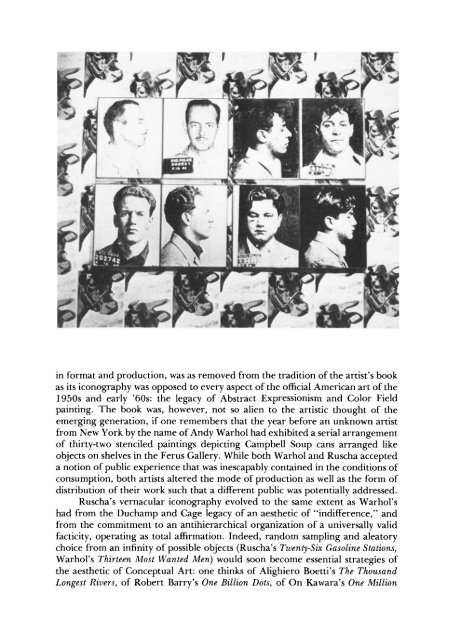in format and production, was as removed from <strong>the</strong> tradition <strong>of</strong> <strong>the</strong> artist's bookas its iconography was opposed <strong>to</strong> every aspect <strong>of</strong> <strong>the</strong> <strong>of</strong>ficial American art <strong>of</strong> <strong>the</strong>1950s and early '60s: <strong>the</strong> legacy <strong>of</strong> Abstract Expressionism and Color Fieldpainting. The book was, however, not so alien <strong>to</strong> <strong>the</strong> artistic thought <strong>of</strong> <strong>the</strong>emerging generation, if one remembers that <strong>the</strong> year before an unknown artistfrom New York by <strong>the</strong> name <strong>of</strong> Andy Warhol had exhibited a serial arrangement<strong>of</strong> thirty-two stenciled paintings depicting Campbell Soup cans arranged likeobjects on shelves in <strong>the</strong> Ferus Gallery. While both Warhol and Ruscha accepteda notion <strong>of</strong> public experience that was inescapably contained in <strong>the</strong> conditions <strong>of</strong>consumption, both artists altered <strong>the</strong> mode <strong>of</strong> production as well as <strong>the</strong> form <strong>of</strong>distribution <strong>of</strong> <strong>the</strong>ir work such that a different public was potentially addressed.Ruscha's vernacular iconography evolved <strong>to</strong> <strong>the</strong> same extent as Warhol'shad from <strong>the</strong> Duchamp and Cage legacy <strong>of</strong> an aes<strong>the</strong>tic <strong>of</strong> "indifference," andfrom <strong>the</strong> commitment <strong>to</strong> an antihierarchical organization <strong>of</strong> a universally validfacticity, operating as <strong>to</strong>tal affirmation. Indeed, random sampling and alea<strong>to</strong>rychoice from an infinity <strong>of</strong> possible objects (Ruscha's Twenty-Six Gasoline Stations,Warhol's Thirteen Most Wanted Men) would soon become essential strategies <strong>of</strong><strong>the</strong> aes<strong>the</strong>tic <strong>of</strong> <strong>Conceptual</strong> <strong>Art</strong>: one thinks <strong>of</strong> Alighiero Boetti's The ThousandLongest Rivers, <strong>of</strong> Robert Barry's One Billion Dots, <strong>of</strong> On Kawara's One Million
OCTOBER Years, or, most significantly in this context, <strong>of</strong> Doug Huebler's life-long project,entitled Variable Piece: 70. This work claims <strong>to</strong> document pho<strong>to</strong>graphically "<strong>the</strong>existence <strong>of</strong> everyone alive in order <strong>to</strong> produce <strong>the</strong> most au<strong>the</strong>ntic and inclusiverepresentation <strong>of</strong> <strong>the</strong> human species that may be'assembled in that manner.Editions <strong>of</strong> this work will be periodically issued in a variety <strong>of</strong> <strong>to</strong>pical modes:'100,000 people,' '1,000,000 people,' '10,000,000 people,' . . . etc." Or again,<strong>the</strong>re are <strong>the</strong> works by Stanley Brouwn or Hanne Darboven where in each casean arbitrary, abstract principle <strong>of</strong> pure quantification replaces traditional principles<strong>of</strong> pic<strong>to</strong>rial or sculptural organization and/or compositional relationalorder.In <strong>the</strong> same manner that Ruscha's books shifted <strong>the</strong> formal organization <strong>of</strong><strong>the</strong> representation, <strong>the</strong> mode <strong>of</strong> presentation itself became transformed: instead<strong>of</strong> lifting pho<strong>to</strong>graphic (or print-derived) imagery from mass-cultural sources andtransforming <strong>the</strong>se images in<strong>to</strong> painting (as Warhol and <strong>the</strong> Pop <strong>Art</strong>ists hadpracticed it), Ruscha would now deploy pho<strong>to</strong>graphy directly, in an appropriateprinting medium. And it was a particularly laconic type <strong>of</strong> pho<strong>to</strong>graphy at that,one that explicitly situated itself as much outside <strong>of</strong> all conventions <strong>of</strong> art pho<strong>to</strong>graphyas outside <strong>of</strong> those <strong>of</strong> <strong>the</strong> venerable tradition <strong>of</strong> documentary pho<strong>to</strong>graphy,least <strong>of</strong> all that <strong>of</strong> "concerned" pho<strong>to</strong>graphy. This devotion <strong>to</strong> a deadpan,anonymous, amateurish approach <strong>to</strong> pho<strong>to</strong>graphic form corresponds exactly <strong>to</strong>Ruscha's iconographic choice <strong>of</strong> <strong>the</strong> architectural banal. Thus at all three levels-iconography, representational form, mode <strong>of</strong> distribution -<strong>the</strong> given forms<strong>of</strong> artistic object no longer seemed acceptable in <strong>the</strong>ir traditionally specializedand privileged positions. As Vic<strong>to</strong>r Burgin put it with hindsight: "One <strong>of</strong> <strong>the</strong>things <strong>Conceptual</strong> <strong>Art</strong> attempted was <strong>the</strong> dismantling <strong>of</strong> <strong>the</strong> hierarchy <strong>of</strong> mediaaccording <strong>to</strong> which painting (sculpture trailing slightly behind it) is assumedinherently superior <strong>to</strong>, most notably, pho<strong>to</strong>graphy.""Accordingly, even in 1965-66, with <strong>the</strong> earliest stages <strong>of</strong> <strong>Conceptual</strong> practices,we witness <strong>the</strong> emergence <strong>of</strong> diametrically opposed approaches: JosephKosuth's Pro<strong>to</strong>-Investigations on <strong>the</strong> one hand (according <strong>to</strong> <strong>the</strong>ir author conceivedand produced in 1965);18 and a work such as Dan Graham's Homes for17. Vic<strong>to</strong>r Burgin, "The Absence <strong>of</strong> Presence," in The End <strong>of</strong> <strong>Art</strong> Theory (Atlantic Highlands,1986), p. 34.18. In <strong>the</strong> preparation <strong>of</strong> this essay, 1 have not been able <strong>to</strong> find a single source or document thatwould confirm with definite credibility Kosuth's claim that <strong>the</strong>se works <strong>of</strong> <strong>the</strong> Pro<strong>to</strong>-Investigationswere actually produced and existed physically in 1965 or 1966, when he (at that time twenty yearsold) was still a student at <strong>the</strong> School <strong>of</strong> Visual <strong>Art</strong>s in New York. Nor was Kosuth able <strong>to</strong> provide anydocuments <strong>to</strong> make <strong>the</strong> claims verifiable. By contrast <strong>the</strong>se claims were explicitly contested by all <strong>the</strong>artists I interviewed who knew Kosuth at that time, none <strong>of</strong> <strong>the</strong>m remembering seeing any <strong>of</strong> <strong>the</strong>Pro<strong>to</strong>-Investigations before February 1967, in <strong>the</strong> exhibition Non-Anthropomorphic <strong>Art</strong> by Four Young<strong>Art</strong>ists, organized by Joseph Kosuth at <strong>the</strong> Lannis Gallery. The artists with whom I conductedinterviews were Robert Barry, Mel Bochner, Dan Graham, and Lawrence Weiner. I am not necessarilysuggesting that <strong>the</strong> Pro<strong>to</strong>-Investigations could not have been done by Kosuth at <strong>the</strong> age <strong>of</strong> twenty(after all, Frank Stella had painted his Black Paintings at age twenty-three), or that <strong>the</strong> logical steps
















